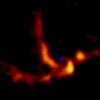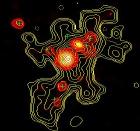| Star Formation in the Galactic Nuclear Region | |||||||||||||
|
Abstract The ionized core in the Sgr B2 Main star-forming region was imaged using the Submillimeter Array archival data observed for the H26a line and continuum emission at 0.86 millimeter with an angular resolution 0.3". Eight hyper-compact H26a emission sources were detected with a typical size in the range of 1.6--20x102 AU and electron density of 0.3--3x107 cm-3, corresponding to the emission measure 0.4--8.4x1010 cm-6 pc. The H26a line fluxes from the eight hyper-compact HII sources imply that the ionization for each of the sources must be powered by a Lyman continuum flux from an O star or a cluster of B stars. The most luminous H26a source among the eight detected requires an O6 star that appears to be embedded in the ultra-compact HII region F3. In addition, ~23 compact continuum emission sources were also detected within the central 5"x3",(~0.2 pc) region. In the assumption of a power-law distribution for the dust temperature, with the observed brightness temperature of the dust emission we determined the physical properties of the submillimeter emission sources showing that the molecular densities are in the range of 1--10x108 cm-3, surface densities between 13 to 150 g cm-2, and total gas masses in the range from 5 to > 200 Mo which are 1 or 2 orders of magnitude greater than the corresponding values of the Bonnor-Ebert mass. With a mean free-fall time scale of 2x103 y, each of the massive protostellar cores are undergoing gravitational collapse to form new massive stars in the Sgr B2 Main core.
Abstract Observations of two H2CO (303-202 and 321-220) lines and continuum emission at 1.3 mm toward Sgr B2(N) and Sgr B2(M) have been carried out with the SMA. The mosaic maps of Sgr B2(N) and Sgr B2(M) in both continuum and lines show a complex distribution of dust and molecular gas in both clumps and filaments surrounding the compact star formation cores. We have observed a decelerating outflow originated from the Sgr B2(M) core, showing that both the redshifted and blueshifted outflow components have a common terminal velocity. This terminal velocity is 58+/-2 km s-1. It provides an excellent method for determination of the systematic velocity of the molecular cloud. The SMA observations have also shown that a large fraction of absorption against the two continuum cores is redshifted with respect to the systematic velocities of Sgr B2(N) and Sgr B2(M), respectively, suggesting that the majority of the dense molecular gas is flowing into the two major cores where massive stars have been formed. We have solved the radiative transfer in a multilevel system with LVG approximation. The observed H2CO line intensities and their ratios can be adequately fitted with this model for the most of the gas components. However, the line intensities between the higher energy level transition H2CO(321-220) and the lower energy level transition H2CO(303-202) is reversed in the redshifted outflow region of Sgr B2(M), suggesting the presence of inversion in population between the ground levels in the two K ladders (K-1=0 and 2). The possibility of weak maser processes for the H2CO emission in Sgr B2(M) is discussed.
Abstract Multifrequency spectral line and continuum observation of ionized gas in the -30 km s-1 molecular cloud (G0.04+0.03) have been carried out using the VLA to study the nature of the discrete radio sources located between Sgr A West (l = 0 deg) and the arched filaments of the continuum arc (l = 0.2 deg). Spectral indices determined from 6 and 20 cm continuum data indicate that the spectra of these sources are flat or rising with frequency. Radio morphologies and the detection of radio recombination lines (H110alpha and H92alpha) confirm that these sources are H II regions. The line emission arises at negative radial velocities (-60 to -20 km s-1), forbidden at these longitudes in the sense of Galactic rotation. The kinematics of the ionized gas suggest a close relationship with the molecular cloud observed in CS and 13CO at a mean radial velocity of -30 km s-1 (G0.04+0.03). We derive LTE electron temperatures in the range 3500-7200 K. The low inferred electron temperatures may indicate relatively high metal abundances in these regions. The thermal sources are spatially correlated with [C II] 158 microns emission peaks and with the distribution of warm dust as indicated by the color temperature, Tc(55/125 mircon). Overall, their properties and environments indicate that these H II regions are ionized by UV radiation from recently formed early-type stars in the molecular cloud at -30 km s-1.
| |||||||||||||








